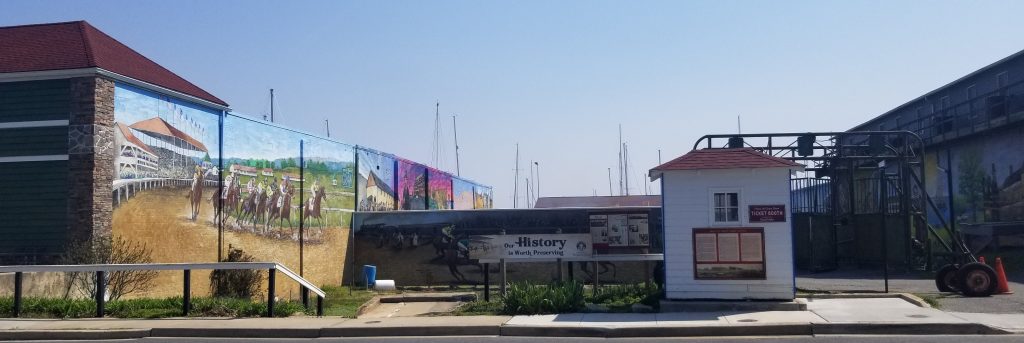
In a little Maryland town beside the Chesapeake Bay there once stood a stylish racetrack that showcased renowned stables, champion trainers and legendary horses. Named after the town where it stood, Havre de Grace Racetrack was conceived after the passage of anti-wagering laws in New York in 1908 led to the closing of several tracks in that state. The officials of Harford County realized that New York’s loss would be Maryland’s gain so in 1912, they approved pari-mutuel betting. In an incredible show of efficiency, construction on the track was completed within a month at a cost of $20,000 for the land and $125,000 for the grandstand. Ownership of the track was listed as the Harford Agriculture and Breeders Association, but it was August Belmont himself who provided most of the financial resources. Many New York officials including Walter Vosburgh quickly signed on to Belmont’s newest racing venture and Edward Burke, who was the best price-maker in the state, was chosen to run the track.
But there was one other person who also owned a stake in Havre de Grace Racetrack – Arnold Rothstein, aka, “The Brain”. At the time Rothstein was merely a casino-owner and notorious gambler but he would eventually go on to orchestrate the 1919 “Black Sox Scandal”, conspire to drive up the odds in the 1921 Travers Stakes on Sporting Blood (the eventual race-winner which he also happened to own), and rub shoulders with Meyer Lansky, Jack “Legs” Diamond, Charles “Lucky” Luciano, and Dutch Schultz. And fix races at his own track. Eventually, he would be bought out by the other shareholders but his illegal activities and mob ties left their mark on the little town.

On August 24, 1912 Havre de Grace Racetrack opened to a crowd of 5,000 and was an immediate success. Lured by fifty cent roundtrip railway tickets, racegoers from New York, Philadelphia, Baltimore, Delaware, and Washington D.C. flocked to the track, now affectionately known as “The Graw”. Daily attendance averaged 6,000 and it wasn’t long before racing’s biggest stars came calling. In 1915, Roamer notched a victory in the Havre de Grace Handicap en route to Champion Older Horse honors while Cudgel defeated Exterminator and Sir Barton in the 1919 edition. Then in 1920, the magnificent Man O’ War gave perhaps the most jaw-dropping performance of his career in the Potomac Handicap. Shouldering a crushing 138 pounds – 24 to 34 more than his opponents – the three-year-old colt won by 1 ½ lengths under wraps and shattered the track record for 1 1/16 mile event.

The 1920’s also brought more than champion racehorses to Havre de Grace, however. Speak-easys, prostitution, bootleggers and underground casinos flourished during the Prohibition years and the seaside town earned a reputation as a “Little Chicago”. Al Capone was a frequent guest at the Chesapeake Hotel and The Graw. In 1922, bootlegger Chris Martin was arrested after a low-flying airplane over the track alerted dry agents to his illicit operations. Martin was notorious for throwing elaborate parties where the alcohol flowed freely as well as running a “lunch stand” next to his house where food was not on the menu.
In 1936, Man O’ War’s greatest son, War Admiral, broke his maiden at first asking at The Graw. As a three-year-old, War Admiral returned to score wins in an allowance race and the Chesapeake Stakes before his Triple Crown sweep. But it was Seabiscuit’s overwhelming victory in the 1938 Havre de Grace Handicap that brought fans to their feet.

Triple Crown winner Citation was the last “big” horse to grace The Graw. Like War Admiral, he broke his maiden at Havre de Grace in his first career start. However, his return visit as a three-year-old proved disappointing as he suffered his only defeat that year to the longshot Saggy in the Chesapeake Trial. Citation rebounded in his next start, the Chesapeake Stakes, which marked the start of an amazing 16-race win streak that included the Triple Crown.
But the golden age for Havre de Grace was coming to an end. The newer and more conveniently located Delaware Park and Garden State Park lured away racegoers from the Tri-state area. In 1940, pari-mutuel wagering was once again legalized in New York and many stables returned to their home state. New York racing fans no longer saw a need to take long train rides when they could play the ponies in their own backyard. But perhaps the biggest loss was Edward Burke, The Graw’s long-time manager who passed away in 1943. General Milton Reckford of the Maryland National Guard took over the position and while he was unable to prevent the track’s imminent demise, he would prove instrumental in preserving part of its legacy. On April 26, 1950 Havre de Grace Racetrack raced for the last time. On January 1, 1951, it was sold for $1.8 million to the Union Trust Company with Pimlico Racecourse obtaining its racing and betting rights. The track itself was sold to the Maryland National Guard in a $10 purchase deal. Today, the Clubhouse now serves as the National Guard’s headquarters while its grandstand has been enclosed and used as a storage facility.
Yet, while the physical racetrack may be gone, its legend lives on. The original ticket booth and colorful murals depicting Seabiscuit’s Potomac Handicap and Citation’s Chesapeake Stakes victories can be found on Market Street in downtown Havre de Grace. Another mural, entitled, “Dream Race at The Graw” features the immortals who had raced there – Sir Barton, Exterminator, Man O’ War, Seabiscuit, War Admiral, Whirlaway, and Citation. It also includes a champion filly, one that had never raced at The Graw but was named in its honor – Havre de Grace. Best known for defeating colts in the 2011 Woodward Stakes, Havre de Grace earned over $2.5 million and was voted Champion Older Female Horse and Horse of the Year in 2011. This fantastic filly will forever be remembered not only for her racing accomplishments but also as a tribute to the treasured track whose name she shares.
Photos: Courtesy of Dawn LeFevre



